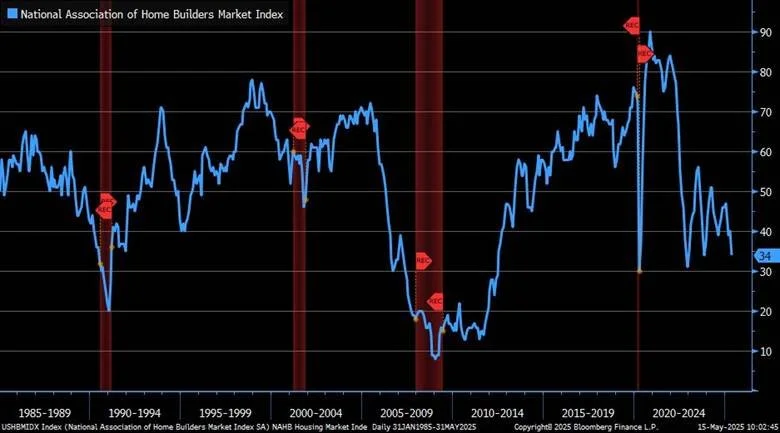H.O.P.E. Starts with Housing
I’d like to be bullish on the housing market. I’d love to find data that suggests moribund housing turnover is on the verge of acceleration, that the growing stock of completed unsold inventory was poised to be absorbed, that the slowing rate of change of national home prices was bottoming. Unfortunately, the data is telling us the opposite. The above chart depicts the sentiment of large and small homebuilders across the country. As you can see, the trend isn’t favorable.
To be clear, our view is not that everything is negative in the world of housing. There are two secular factors that are supportive. The first is the fact that, following the 2008 housing crash, we underbuilt housing for more than a decade and there are many parts of the country that remain underbuilt. The second factor is The Great Wealth Transfer. To say the least, the Boomers are flush: richer than any previous generation by a long shot. While estimates vary, somewhere on the order of $2 Trillion of wealth will migrate from Boomers to Millennials annually over the ensuing decade. Zelman and Associates estimates that as much as one third of all housing purchases today are facilitated by a gift from a parent. That appears to have allowed demand to remain solid in the face of unprecedented housing unaffordability.
But the cyclical pressures, in the short term, tend to overwhelm the secular lift. Three very important states now have housing prices down year over year: California, Texas and Florida. While equities have rallied powerfully in recent weeks, housing stocks remain laggards. The dour sentiment among the builders reflects a number of factors. Costs are rising like lumber and labor costs where deportations are not helping. Buyer traffic remains weak and mortgage buydowns, which have been critical to clearing inventory, are pressuring margins.
The critical factor going forward is the 30-year mortgage rate. With the 10-year Treasury at 4.5% and mortgage spreads at higher-than-normal levels, we are left with a fixed mortgage rate of around 7%. We know from the past couple years that level is far too high to stimulate demand. Well, what if rates go lower? That would be bullish for housing, but one has to ask the question: why are rates going to be lower in the face of accelerating goods inflation driven by tariffs? The only scenario I could envision that would take rates lower is rising unemployment and that is not an environment that is bullish for housing demand and/or credit availability.
We aren’t the only ones to use the H.O.P.E. framework (Housing, Orders, Profits, Employment). Outstanding strategists like Piper Sandler’s Michael Kantrowitz and 42Macro’s Darius Dale also focus on looking at housing as the first leg to understanding the business cycle. They and I recognize that it is very unlikely we see a recession without a housing recession or an acceleration in the economy without housing leading the way. While we are always looking at justifications to be more positive, there simply isn’t much hope for that in the housing sector at this point.
Tim Pierotti is WealthVest’s Chief Investment Officer.
Tim has over 25 years of experience in various aspects of the equities business. Prior to joining WealthVest, Mr. Pierotti spent seven years in Equity Research management roles at Deutsche Bank and most recently at BMO where he was a Managing Director and Head of US Product Management. Tim has 11 years of investment experience most notably as Head of Consumer Research and Portfolio Manager at The Galleon Group, a former NY based $8Bln Long/Short hedge fund. Tim is a graduate of Boston College and lives in Summit NJ.
WealthVest makes no representation or warranty, expressed or implied, with respect to the accuracy, reasonableness, or completeness of any of the statements made in this material, including, but not limited to, statements obtained from third parties. Opinions, estimates and projections constitute the current judgment of Tim as of the date indicated. They do not necessarily reflect the views and opinions of WealthVest and are subject to change at any time without notice. WealthVest does not have any responsibility to update this material to account for such changes. There can be no assurance that any trends discussed during this material will continue.
Statements made in this material are not intended to provide, and should not be relied upon for, accounting, legal or tax advice and do not constitute an investment recommendation or investment advice. Investors should make an independent investigation of the information discussed in this material, including consulting their tax, legal, accounting or other advisors about such information. WealthVest does not act for you and is not responsible for providing you with the protections afforded to its clients. This material does not constitute an offer to sell, or the solicitation of an offer to buy, any security, product or service, including interest in any investment product or fund or account managed or advised by WealthVest.
Certain statements made in this material may be “forward-looking” in nature. Due to various risks and uncertainties, actual events or results may differ materially from those reflected or contemplated in such forward-looking information. As such, undue reliance should not be placed on such statements. Forward-looking statements may be identified by the use of terminology including, but not limited to, “may”, “will”, “should”, “expect”, “anticipate”, “target”, “project”, “estimate”, “intend”, “continue” or “believe” or the negatives thereof or other variations thereon or comparable terminology.
The S&P 500® is a trademark of Standard & Poor’s Financial Services, LLC and its affiliates and for certain fixed index annuity contracts is licensed for use by the insurance company producer, and the related products are not sponsored, endorsed, sold or promoted by S&P Dow Jones Indices LLC or their affiliates, none of which make any representation regarding the advisability of purchasing such a product. WealthVest is not affiliated with, nor does it have a direct business relationship with Standard & Poors Financial Services, LLC.



